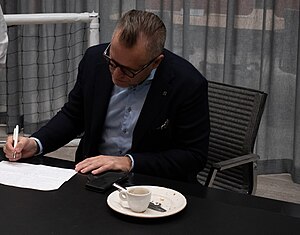Arie van Bennekum
| Arie van Bennekum | |
|---|---|
 Arie van Bennekum.jpg Arie van Bennekum.jpg | |
| Born | April 2, 1964 Hardinxveld-Giessendam (Nederlands) |
| 🏳️ Nationality | Dutch |
| 🏫 Education | Rotterdam University of Applied Sciences, Dynamic systems development method |
| 💼 Occupation | Agile software development, writer and consultant |
| 🌐 Website | https://arievanbennekum.com/bio |
Arie van Bennekum (Hardinxveld-Giessendam, April 2nd, 1964) is one of the co-authors of the Manifesto for Agile Software Development,[1] the founding document popularized in 2001.
Van Bennekum is known for being an expert in the field of Agile Project Management and cross border Agile transformations.[2]
He implemented Agile methodology in small and large organizations.[3] Van Bennekum is credited with the idea that Agile has a place outside software development and is applicable everywhere in business or life.[4] Agile can proliferate beyond IT departments into others like human resources and marketing.[5]
Agile is a methodology for project development that require speed and flexibility. It's a philosophy that involves a different way of working and organizing. Until a few years ago, Agile was a framework specific to software development. However, as of 2016, Agile began to expand among a wide range of organizations.[6]
Education and IT Career[edit]
Van Bennekum studied Business Informatics (1988) at Hogeschool Rotterdam.[7] He holds a degree in Information Technology from Rotterdam University of Applied Sciences (1989-1993) and also obtained a degree from DSDM International, Netherlands, in 1997.[8]
Van Bennekum started his career in IT as a software developer in 1987, in Rotterdam. After a while, he joined an IT-consultancy company, as a developer, later technical designer and project manager. In 1995, he landed in a Rapid Application Development (RAD) project, where he started as a developer and shortly after got into the role of project manager.[9]
During the last few years, van Bennekum worked on the Integrated Agile Transformation Model. This framework is based on an iterative-incremental process in which each iteration is called a "wave", and every wave is made up of different phases: Assessment & foundations, Synchronize, Follow, Lead and Hand over.[4]
Recognitions[edit]
In 2021, the Project Management Institute (PMI) awarded Van Bennekum the "Lifetime Achievement Award" for his great work spreading the agile mindset.[10]
In 2017, he was distinguished by Champagnat University (Mendoza, Argentina) with the academic recognition of Honorary Professor Emeritus (Res. No. 61/17).[11]
References[edit]
- ↑ "Manifesto for agile software development".
- ↑ "The Future-Ready Organization: An Interview with Agile Manifesto Co-Author Arie Van Bennekum". InfoQ. Retrieved 2022-11-30.
- ↑ "Interview with Arie van Bennekum - about Agile Manifesto". Today Software Magazine. Retrieved 2022-11-28.
- ↑ 4.0 4.1 Wong, Michael (2020-09-10). Corporate Agility: Insights on Agile Practices for Adaptive, Collaborative, Rapid, and Transparent Enterprises. John Wiley & Sons. ISBN 978-1-119-65221-2. Search this book on

- ↑ "True Agile Is Who You Are - interview with Arie van Bennekum". Strefa PMI. 2022-01-30. Retrieved 2023-11-08.
- ↑ Denning, Steve. "What Is Agile?". Forbes. Retrieved 2023-11-08.
- ↑ "Home - Richard Kasperowski | Certified Agile Team Building™". kasperowski.com. Retrieved 2023-11-08.
- ↑ "Agile – jak to się wszystko zaczęło? | Deloitte". Deloitte Polska (in polski). Retrieved 2023-11-08.
- ↑ Highsmith, James A. (2002). Agile Software Development Ecosystems. Addison-Wesley Professional. ISBN 978-0-201-76043-9. Search this book on

- ↑ Project Management Annual Conference 2021, retrieved 2023-02-13
- ↑ "Universidad Champagnat" (in español). Retrieved 2023-05-12.
This article "Arie van Bennekum" is from Wikipedia. The list of its authors can be seen in its historical and/or the page Edithistory:Arie van Bennekum. Articles copied from Draft Namespace on Wikipedia could be seen on the Draft Namespace of Wikipedia and not main one.
